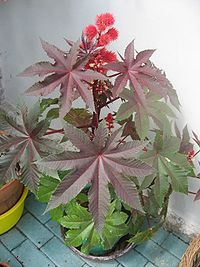Ricin
 From Conservapedia
From Conservapedia 
Ricin is an extremely toxic chemical produced by the seeds (or beans) of the "castor oil" plant (Ricinus communis). It achieved notoriety when it was used by the Bulgarian secret police to assassinate the BBC journalist Georgi Markov on Waterloo Bridge in 1978.[1]
Method of Action[edit]
Ricin is made up of two polypeptide chains, A and B, linked by a disulfide bridge. The B chain attaches itself to a glycoprotein on the target cell and causes the molecule to be invaginated into the cell inside a vacuole. Once inside the cell the change in environment causes the disulfide bridge to break, and the B chain then forms a pore in the vacuole allowing the A chain to escape into the cell. The A chain then inhibits protein synthesis and eventually causes cell death.[2]
References[edit]
- ↑ BBC News: Flashback: Dissident's poisoning
- ↑ "Introduction to Toxicology" 2nd edition - J.A.Timbrell
Categories: [Poisons]
↧ Download as ZWI file | Last modified: 02/06/2023 03:35:53 | 85 views
☰ Source: https://www.conservapedia.com/Ricin | License: CC BY-SA 3.0
 ZWI signed:
ZWI signed: KSF
KSF